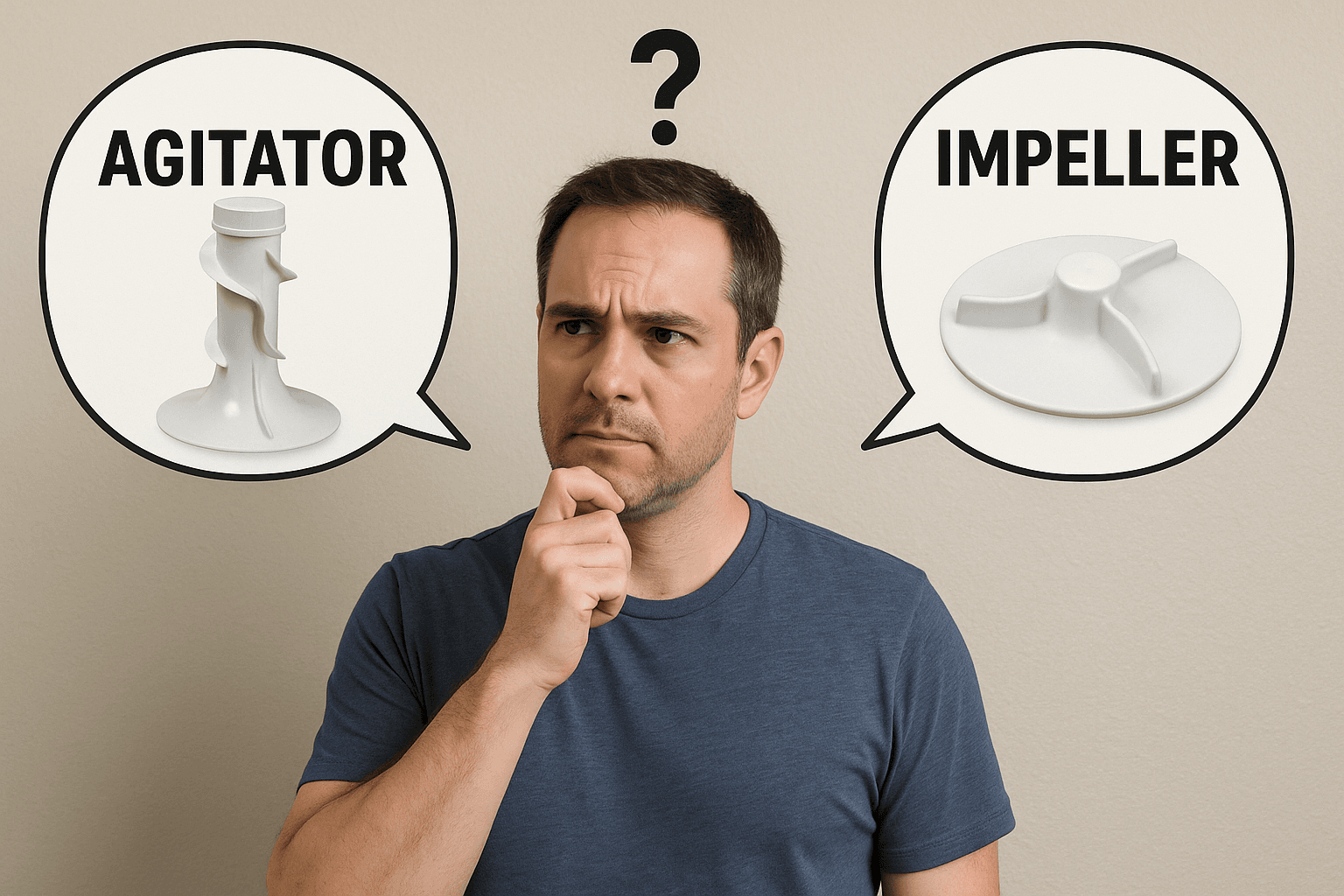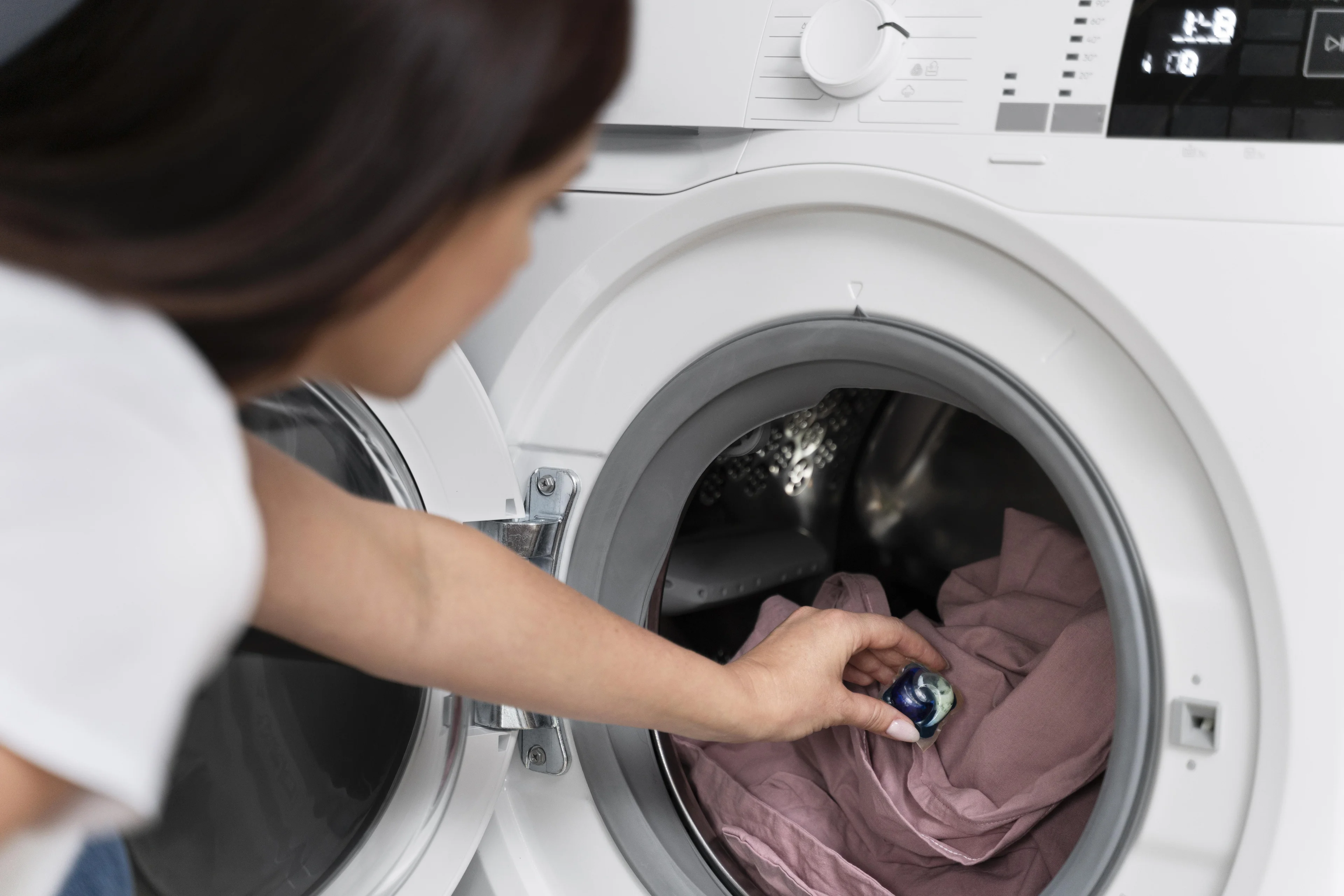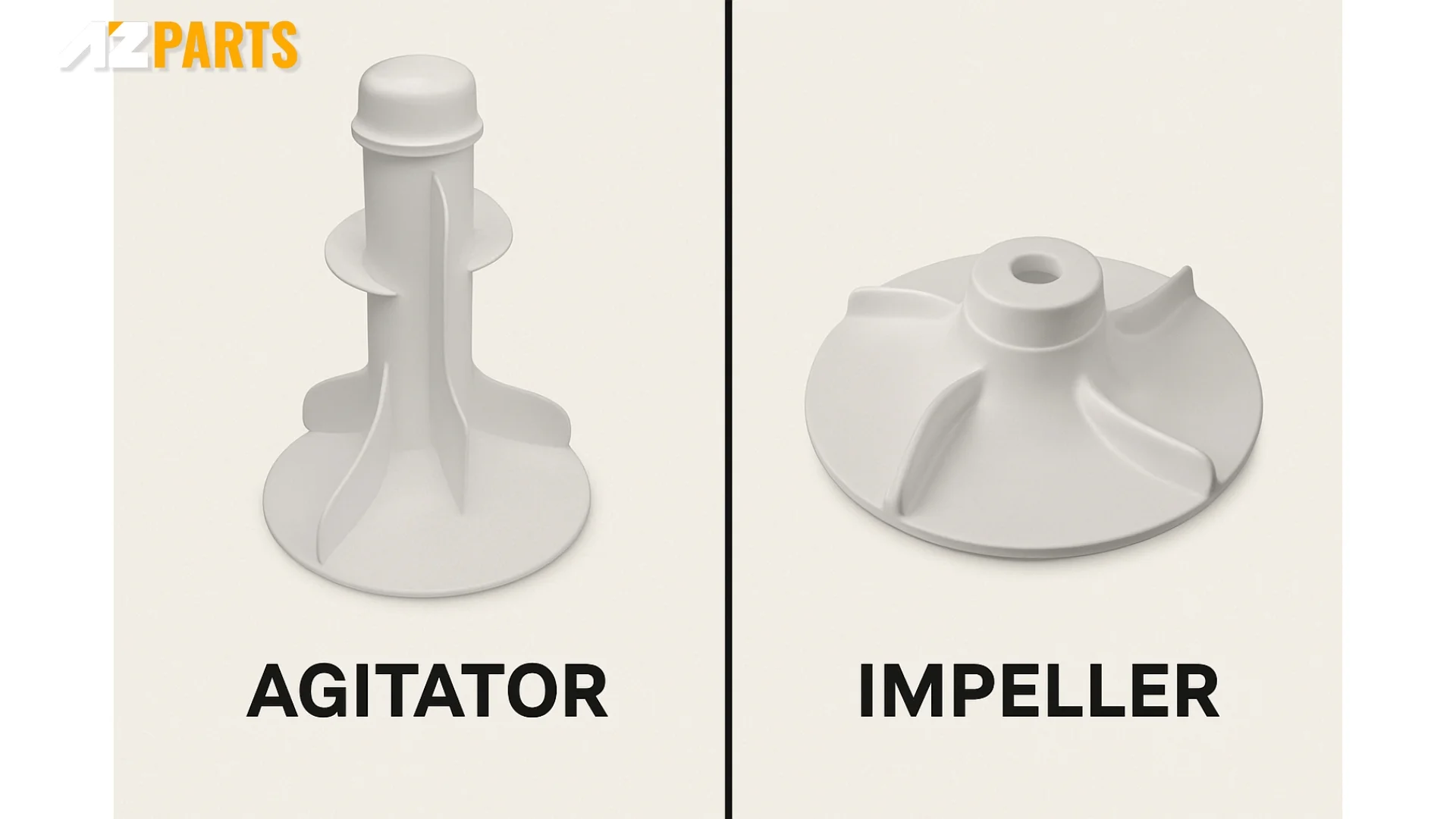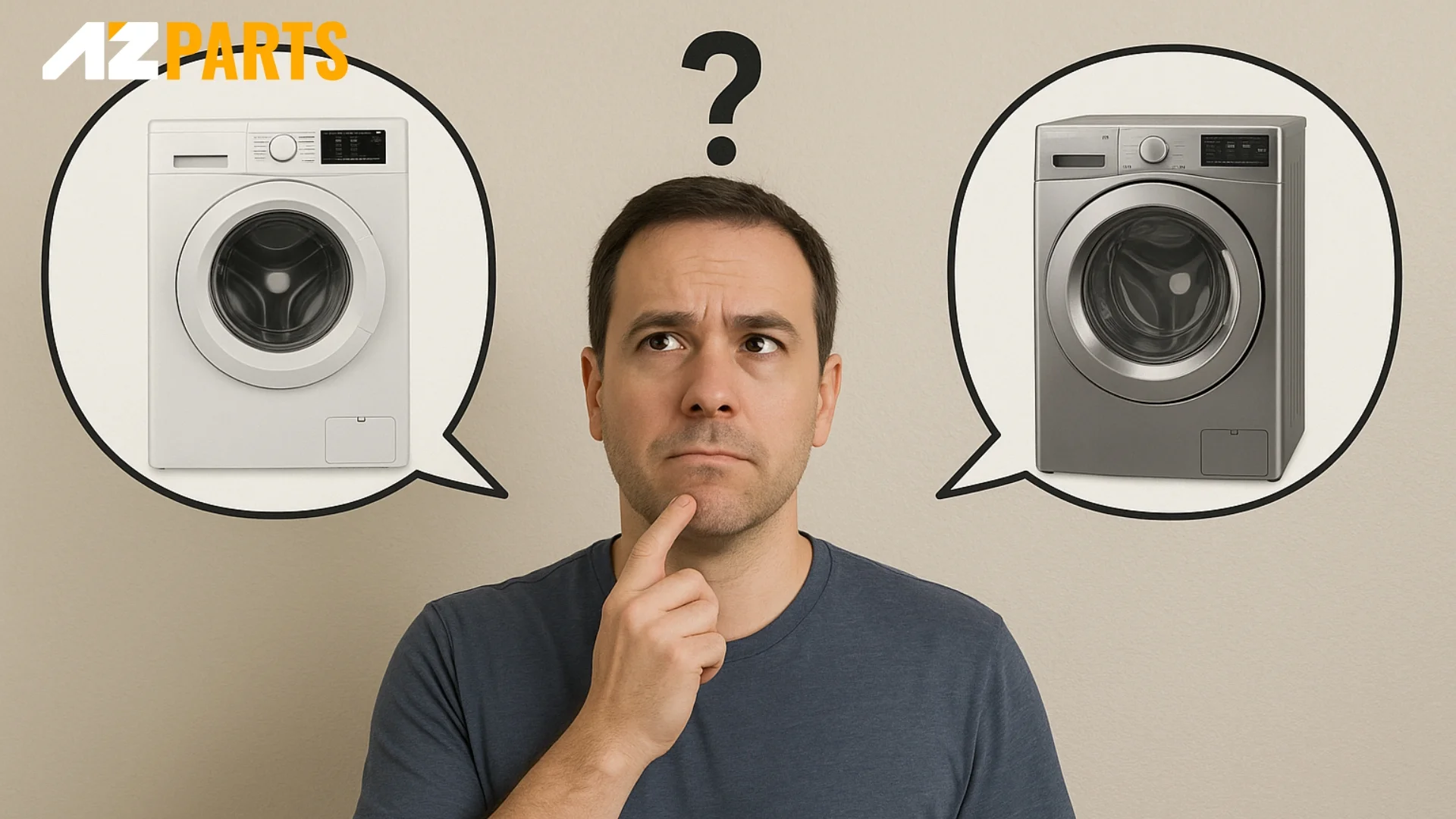Review
Agitator vs. Impeller Washer: Which One Should You Pick?
AZparts Team
Updated on July 14, 2025
6 min read
When shopping for a new washing machine, one of the key decisions you’ll face is choosing between an agitator or an impeller model. In this guide, AZParts will break down the difference between these washer replacement parts, explain how they work, and help you decide which suits your home best.

1. Agitator and Impeller: What Makes Them Different?
An agitator is a central post located in the drum of many top-loading washers. It uses a combination of back-and-forth motion and fins or vanes to rub against clothes, dislodging dirt and stains effectively. The agitator washer meaning often implies a powerful clean that’s suitable for heavy-duty laundry.
On the other hand, an impeller is a low-profile cone or disc at the bottom of the washer tub. Instead of rubbing clothes, it uses high-speed spinning and water flow to generate a gentle yet effective impeller washer cleaning action. In the growing debate of agitator vs impeller washing machine, this modern design is preferred for its efficiency and fabric care.
2. How Does an Agitator Work Inside a Washer?
In a traditional top-loading washing machine, the agitator is the key component responsible for the mechanical action that removes dirt and stains. It is typically a tall, vertical spindle located in the center of the wash basket, outfitted with fins or vanes that extend outward. The most common designs include straight-vane agitators and dual-action agitators, the latter featuring a rotating spiral top and a finned bottom section. This design is central to the agitator washer meaning and its reputation for robust cleaning performance.
During the wash cycle, the agitator moves back and forth (oscillates), twisting clothes around and forcing them to rub against both the agitator and each other. This vigorous movement produces the friction needed to lift dirt from fabric surfaces. In dual-action models, the upper part rotates clockwise, pushing clothes downward, while the lower fins provide a more intense scrubbing action. This motion also circulates water and detergent evenly throughout the tub, enhancing the cleaning process and ensuring detergent reaches all areas of the load.
Check out more: Your Washer Agitator Not Working? How to Fix

Washer Agitator (Source: AZParts)
At AZParts, we stock a wide range of agitator washing machine parts and agitator repair parts to keep your machine running efficiently. Whether you’re repairing or upgrading, consider these trusted components:
- WH49X10042 Washer Agitator Coupler Kit
- 16 Packs 80040 Washer Agitator Dogs
- 12 Packs 80040 Washer Agitator
- 4-Pack 80040 Washer Agitator Dogs
These high-quality replacement parts help support the agitator cleaning mechanism, ensuring your washer continues to deliver strong performance wash after wash.
3. How Does an Impeller Washer Clean Clothes?
Impeller washers use powerful water jets and drum motion to remove dirt through a low-friction cleaning process. The impeller washer cleaning action is more water-efficient and gentler on fabrics, making it a great option for delicates and mixed-load laundry.
Because they do not rely on physical agitation, impeller washers often consume less energy and allow for larger loads. If you are seeking how an impeller washer works, think of it as a high-speed whirlpool that sweeps clothes through detergent-rich water.

Impeller washer cleans clothes (Source: Freepik)
4. Which Cleans Better: Agitator or Impeller?
Agitator washers are known for their effective cleaning performance, especially on tough stains and heavily soiled laundry. Their central post uses a vigorous twisting motion to ensure all garments come into contact with detergent and water. This design also supports shorter wash cycles, efficient detergent distribution, and a lower upfront cost, making it a great choice for users who prefer familiar technology and reliable performance on stubborn dirt.

You are confused about whether to choose between Agitator or Impeller (Source: AZParts)
On the other hand, impeller washers offer a gentler wash action by creating water currents that move clothes against each other, reducing fabric wear and tear. They typically feature a larger basket capacity, more efficient water usage, and higher spin speeds, which help shorten drying time. Their streamlined design and ease of loading make them ideal for handling larger laundry loads and delicate fabrics with care.
Finally, both types of washers can effectively clean your clothes. You can choose a suitable component based on factors such as the type of laundry you typically wash, how much laundry you do, your concern for water and energy efficiency, and your personal preferences for wash cycle duration and capacity.
5. How to Choose the Right Washer for Your Home
When choosing the right washer, think about your laundry habits and washer choice. If your household frequently washes bulky loads like comforters or blankets, an impeller washer, with its spacious, unobstructed drum, may be ideal. Its gentler cleaning action also makes it great for delicate fabrics, while high spin speeds help reduce drying time.
Other important considerations include space constraints, load frequency, and fabric types. Top-load agitator washers offer budget-friendly performance and familiarity, whereas top-load impeller models provide more efficient water usage and modern design. For larger families or tight spaces, front-load washers deliver high capacity, stackable options, and energy savings.
Ultimately, the best washer for family use depends on your preferences for functionality, efficiency, and ease of use.

You choose suitable washer for your home (Source: AZParts)
6. Is There a Washer That Has Both an Agitator and Impeller?
Yes, some modern washing machines combine both technologies, offering the flexibility of a washer with agitator and impeller. These hybrid washer models typically feature a removable agitator, allowing users to switch between traditional mechanical cleaning and gentler water-flow cleaning depending on their laundry needs. This dual action washing machine setup gives households the convenience of two washer types in one unit.
When the agitator is installed, the washer delivers vigorous agitation for deep cleaning everyday and heavily soiled items. You need to remove the agitator, and the impeller beneath creates space for bulky loads and offers a gentler wash for delicate fabrics. This setup provides versatility, increased capacity, and flexibility for different load types, making it an ideal choice for families that handle a wide variety of laundry.
In the debate of whether agitator or impeller is better, there’s no one-size-fits-all answer as it ultimately depends on your laundry needs and lifestyle. Agitators offer robust cleaning and speed, while impellers provide gentle care and better efficiency. Apart from options like agitator couplers and agitator cogs, AZParts also offers washer drive belts, door striker parts, drain pump parts and for you to choose the perfect solution to fix your washing machine and keep your laundry routine smooth and effective.
Contact information
- 8 The Green, Ste A, Dover, Delaware 19901-3618, United States
- support@azparts.com
Washer
Further Reading
Further Reading





_1748341252.jpg&w=3840&q=75)